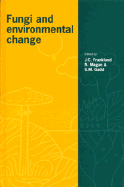Book contents
- Frontmatter
- Contents
- List of contributors
- Preface
- 1 Effects of climate change on fungal diseases of trees
- 2 Effects of climate change on Fusarium foot rot of winter wheat in the United Kingdom
- 3 Effects of UV-B radiation (280–320 nm) on foliar saprotrophs and pathogens
- 4 Implications of global warming and rising sea-levels for macrofungi in UK dune systems
- 5 Red Data Lists and decline in fruiting of macromycetes in relation to pollution and loss of habitat
- 6 Effects of dry-deposited SO2 and sulphite on saprotrophic fungi and decomposition of tree leaf litter
- 7 Effects of atmospheric pollutants on phyllosphere and endophytic fungi
- 8 Influences of acid mist and ozone on the fluorescein diacetate activity of leaf litter
- 9 Mycorrhizas and environmental stress
- 10 Myccorhizas, succession, and the rehabilitation of deforested lands in the humid tropics
- 11 Potential effects on the soil mycoflora of changes in the UK agricultural policy for upland grasslands
- 12 Uptake and immobilization of caesium in UK grassland and forest soils by fungi, following the Chernobyl accident
- 13 Effects of pollutants on aquatic hyphomycetes colonizing leaf material in freshwaters
- 14 Fungi and salt stress
- 15 Fungal sequestration, mobilization and transformation of metals and metalloids
- 16 Urban, industrial and agricultural effects on lichens
- 17 Fungal interactions with metals and radionuclides for environmental bioremediation
- 18 Impact of genetically-modified microorganisms on the terrestrial microbiota including fungi
- 19 Has chaos theory a place in environmental mycology?
- Index of generic and specific names
- Subject index
8 - Influences of acid mist and ozone on the fluorescein diacetate activity of leaf litter
Published online by Cambridge University Press: 05 November 2011
- Frontmatter
- Contents
- List of contributors
- Preface
- 1 Effects of climate change on fungal diseases of trees
- 2 Effects of climate change on Fusarium foot rot of winter wheat in the United Kingdom
- 3 Effects of UV-B radiation (280–320 nm) on foliar saprotrophs and pathogens
- 4 Implications of global warming and rising sea-levels for macrofungi in UK dune systems
- 5 Red Data Lists and decline in fruiting of macromycetes in relation to pollution and loss of habitat
- 6 Effects of dry-deposited SO2 and sulphite on saprotrophic fungi and decomposition of tree leaf litter
- 7 Effects of atmospheric pollutants on phyllosphere and endophytic fungi
- 8 Influences of acid mist and ozone on the fluorescein diacetate activity of leaf litter
- 9 Mycorrhizas and environmental stress
- 10 Myccorhizas, succession, and the rehabilitation of deforested lands in the humid tropics
- 11 Potential effects on the soil mycoflora of changes in the UK agricultural policy for upland grasslands
- 12 Uptake and immobilization of caesium in UK grassland and forest soils by fungi, following the Chernobyl accident
- 13 Effects of pollutants on aquatic hyphomycetes colonizing leaf material in freshwaters
- 14 Fungi and salt stress
- 15 Fungal sequestration, mobilization and transformation of metals and metalloids
- 16 Urban, industrial and agricultural effects on lichens
- 17 Fungal interactions with metals and radionuclides for environmental bioremediation
- 18 Impact of genetically-modified microorganisms on the terrestrial microbiota including fungi
- 19 Has chaos theory a place in environmental mycology?
- Index of generic and specific names
- Subject index
Summary
One of the vital roles played by fungi in ecosystems lies in their being prime agents in the decomposition of plant material, thereby recycling nutrients (Swift, Heal & Anderson, 1979). It has been suggested that one insidious but important effect of pollution may be a reduction in the activity of decomposer communities (Ineson & Gray, 1980; Wookey, Ineson & Mansfield, 1991). Historically, the most significant atmospheric pollutant has been SO2, whose adverse effects on fungal decomposers are well documented (Magan, 1993, also Magan, Chapter 7). In the UK the trend is for SO2 to decline in importance as a pollutant (but see Boddy et al., Chapter 6) while tropospheric ozone and nitrogenous pollutants are increasing (UK Terrestrial Effects Review Group, 1988; UK Review Group on the Impact of Atmospheric Nitrogen, 1994). The effects of these latter two classes of pollutants on fungi are still largely unresearched.
There have been several reports of decomposer activity in litter being adversely affected by treatment with simulated acid precipitation in which pH was controlled by sulphuric acid (Brown, 1985; Skiba & Cresser, 1986). By contrast, ambient rainwater has a significant component of nitric acid, amounting to approximately 30% of total acidity (Warren Spring Laboratory, 1990). Nitrogen has long been known as a promoter of the decay of plant material by fungi (Garrett, 1963), and this additional pollutant load might be expected partially to offset deleterious effects due to sulphurous pollutants.
- Type
- Chapter
- Information
- Fungi and Environmental Change , pp. 102 - 108Publisher: Cambridge University PressPrint publication year: 1996
- 3
- Cited by

